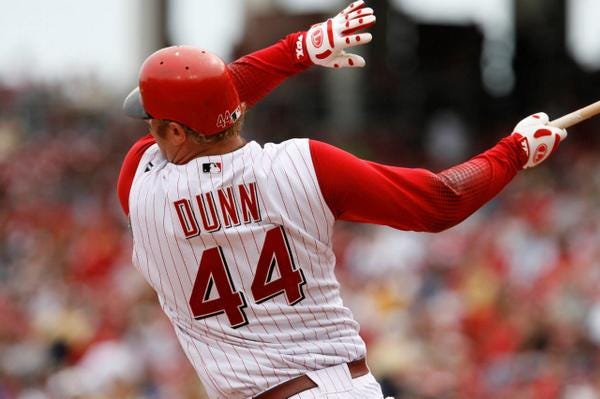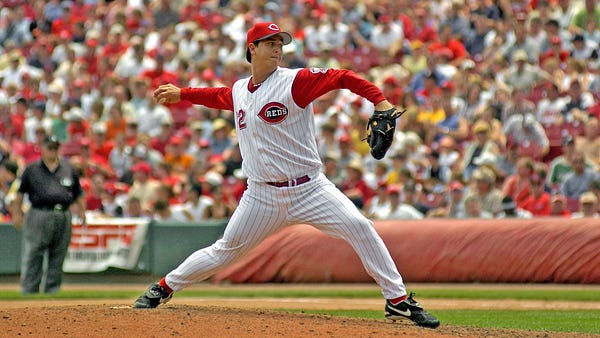Who is the best baseball player of all-time? I love this question, and it’s one that has been debated in bleacher seats, bar rooms, and front porches for more than a century. Everyone has their own opinion, and any one of them could be right (especially mine) depending on how one looks at the question. It’s the age-old baseball dispute, and hardcore fans of America’s pastime love to argue about it.
This series emerged out of my curiosity to determine which player for my favorite team — that’s the Cincinnati Reds, in case you weren’t paying attention — has been the best. Who is the best player ever to wear a Redlegs uniform? Some people will swear that one of the Big Red Machine stars is the best Red who ever played. Some will tell you that Ted Kluszewski or Frank Robinson was the best player they ever saw. You may even find people who will argue for Edd Roush or Ernie Lombardi or Bid McPhee, although you may be hard-pressed to find anyone who actually watched them play.
I grew up with the Reds of the 80s and 90s. Players like Johnny Bench, Pete Rose, and Dave Concepcion were finishing up sterling careers, while future stars like Eric Davis, Barry Larkin, and Jose Rijo were preparing to lead Cincinnati to yet another World Series championship.
Since my father and grandfather were both Reds fans, I grew up with an appreciation for the storied history of this wonderful franchise. In many ways, this is the series I have wanted to write my entire life. By researching and comparing players, I suppose that I wanted simply to answer the questions for myself: who really is the best player in Reds history, and why? Who else makes the list?
Listen, I’ve tried to look at these great players objectively, but this is an inherently subjective project. Spoiler alert: my personal favorite player of all-time did not reach the top spot on the list. I’ve tried to compare Reds, even across eras, using the statistical metrics available to us in the 21st century; I have also taken into account, to some extent, anecdotal evidence, including how these players were judged by their peers, and by the fans.
In some cases, I had to make judgment calls. One of those was how to look at career value versus a player’s peak value. I call this the “Pete Rose Problem.” (Well, it’s one of the Pete Rose Problems, anyway.) Some people had long, good careers, while others burned brighter, but for a much shorter period of time. Ultimately, I had to decide whether the career contributions of a player like Rose trumped the superiority of other players' shorter careers (and higher peaks).
For example, in 1994, Kevin Mitchell had one of the greatest seasons at the plate in Reds history, more productive than any one season in Pete Rose’s long career. No one in his or her right mind, however, would argue that Mitchell was a better Red than Rose. (I don’t think I’m going to argue that here, for the record.) I encountered that dilemma with several players, and I attempted to resolve it as best I could.
Many will disagree with my choices. You’ll probably think of players that I should have included on this list, and others that I’ve ranked too high or too low. That’s the beauty of a list like this, and what makes such an undertaking so much fun. Each ranking is a potential debate over whether that particular player should be ranked higher or lower. While I expect disagreement, however, I believe that my reasons for each of the choices are based in fact, and are defensible. In other words: don’t yell at me.
I don’t know how long this project will take, but it begins here. The top fifty will get full essays about their lives and careers. I’ll spend a little less time on the next 51, but they’re all good players who deserve to be remembered. We’ll begin with Number 101 on what I’m calling “The Big 101” (get it?). Let’s count ‘em down, shall we?
101. Danny Graves
The only player in baseball history to have been born in Vietnam, Graves debuted with Cleveland as a 22-year-old in 1996. Midway through the following season, the young reliever was dealt to Cincinnati, along with immortals such as Jim Crowell, Damian Jackson and Scott Winchester, in exchange for Jeff Branson and John Smiley.
Over the course of nine seasons with the Redlegs, Graves racked up 182 saves, far and away the highest total in franchise history. He was a two-time All-Star, and was probably better than you remember. In Graves’ first five full seasons with the Reds, he was one of the best relievers in baseball, with a 3.23 ERA, 140 ERA+, and 129 saves in 337 appearances. Unfortunately, many Reds fans remember the 2003 season, when Cincinnati manager Bob Boone inexplicably moved Graves to the starting rotation and Graves finished 4-15 with a 5.33 ERA. The following season, a return to the bullpen saw Graves save a career-high 41 games with a second berth on the NL All-Star team.
Obviously, this spot on the list could have gone to a number of other names. In the end, I was compelled by this: Did you know that only four pitchers in Reds history have ever appeared in more games than Danny Graves? He’s not yet a Reds Hall of Famer, but he should be.
100. Jesse Winker
Did you know that Jesse Winker ranks 13th in Reds history in adjusted OPS+ (among players with at least 1500 plate appearances)? Did you know Winker’s career 129 OPS+ with the Reds is better than Ted Kluszewski, Tony Perez, Johnny Bench, Ernie Lombardi, Pete Rose, and Junior Griffey?
Okay, I will accept the criticism that I’m picking and choosing a newfangled stat in order to make the case for a guy that I really liked. Maybe! But the fact is that Winker, an All-Star in 2021, was really good in Cincinnati. Sure, it was for a short time (“Pete Rose Problem” alert), but Winker’s OBP of .385 is among the top five in franchise history, post-1900. He’s even in the top ten for slugging percentage in Reds history! I think he deserves a spot on this list. Sorry, Austin Kearns.
99. Hal Chase
Hal Chase was already 33 when he joined the Reds in 1916, jumping back to the National League from the Buffalo Blues of the upstart Federal League. In his first season with the club, Chase won the batting title, hitting .339 while also leading the league in hits (184) and OPS+ (155),* and finishing second in RBI (82) and slugging percentage (.459). That was a 4.2 WAR season, a single-season total topped by only ten Reds first basemen ever.
*Do you think the OPS+ standings were printed in the daily papers in 1916?
Chase made his name with the glove, however; it’s quite possible that he was the finest defensive first baseman of all-time. In his Historical Baseball Abstract, Bill James said that no “player in baseball history was so richly praised for his defensive skill”:
No one ever saw him play without being left gasping for adjectives, and though his statistics may not explain why, he was routinely described as a great player. “His range was incredible,” says Fred Lieb. “No other first baseman played so far off the bag. As a man charging in on a bunt, he was fantastic. He was speed and grace personified.”
Unfortunately, he was also “the most notoriously corrupt player in baseball history,” according to some accounts. Whether it was fixing games by bribing teammates or dodgy on-field shenanigans, Chase was accused of a long string of questionable behavior. In 1918, Reds manager Christy Mathewson accused Chase of violating league Rule 40 — “Crookedness and Its Penalties” — by offering bribes to teammates and opponents alike. Shortly, however, Mathewson went off to serve in the Great War and Chase was controversially acquitted of the charges by league president John Heydler.
That was the end of Chase’s tenure in Cincinnati. He signed with the New York Giants for the following season but by September, Chase’s career was over. He had yet again been attempting to bribe his teammates to throw games.
But the story doesn’t end there! Even after leaving town, Chase wasn’t done with the Reds. He was later indicted for his role in the 1919 Black Sox scandal, which handed that World Series to Cincinnati. Even though the Reds would have won anyway, right?
To be continued…
What I’m reading
Bronson Arroyo has been elected to the Reds Hall of Fame, and he reflected on a brilliant career: “It probably took me the better part of the first three months of that season in ’06 to really stop watching Red Sox games and feel like I was really a part of that Reds locker room.”
Paul Dehner Jr. discusses the ramifications of the Bengals’ deadline-day silence ($): “This has been their default setting since the beginning of time, and trading away picks or any specific player who could help them win a game this season has never been of particular interest.”
Grant Freking sums up a breakthrough season for FC Cincinnati: “Set in isolation, FC Cincinnati’s 2022 season was wildly successful. But when put in the context of the misery of 2019 through 2021, which featured three straight league-worst finishes and multiple MLS records set for futility, this season is damn near cause for a parade and statues outside TQL Stadium.”
You can follow me on Twitter @dotsonc, if you’d like. The Riverfront is on Twitter, Instagram, Facebook, and YouTube too. You can also join The Riverfront Family at Patreon.






